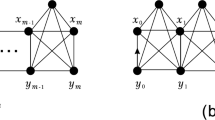Abstract
A periodic linear chain consists of a weighted \(2n\)-path where new edges have been added following a certain periodicity. In this paper, we obtain the effective resistance and the Kirchhoff index of a periodic linear chain as non trivial functions of the corresponding expressions for the path. We compute the expression of the Kirchhoff index of any homogeneous and periodic linear chain which generalizes the previously known results for ladder-like and hexagonal chains, that correspond to periods one and two respectively.


Similar content being viewed by others
References
A. Carmona, A.M. Encinas, M. Mitjana, Green matrices associated with generalized linear polyominoes. Linear Algebra Appl. 468, 38–47 (2015)
A. Carmona, A.M. Encinas, M. Mitjana, Effective resistances for ladder-like chains. Int. J. Quantum Chem. 114, 1670–1677 (2014)
D.J. Klein, M. Randi\(\grave{{\rm c}}\), Resistance distance. J. Math. Chem. 12, 81–95 (1993)
J.C. Mason, D.C. Handscomb, Chebyshev Polynomials (Chapman and Hall/CRC, London, 2003)
W. Xiao, I. Gutman, Resistance distance and Laplacian spectrum. Theor. Chem. Acc. 110, 284–289 (2003)
Y. Yang, H. Zhang, Kirchhoff index of linear hexagonal chains. Int. J. Quantum Chem. 108, 503–512 (2008)
H. Zhang, Y. Yang, C. Li, Kirchhoff index of composite graphs. Discrete Appl. Math. 157, 2918–2927 (2009)
Author information
Authors and Affiliations
Corresponding author
Additional information
This work has been partly supported by the Spanish Research Council under projects MTM2011-28800-C02-01 and MTM2011-28800-C02-02.
Appendix
Appendix
If for any \(k\in \mathbb {Z},\, T_k\) and \(U_k\) are the \(k\)th Chebyshev polynomials of first and second kind respectively, see [4], it is well-known that for any sequence of Chebyshev polynomials \(\{P_k\}_{k\in \mathbb {Z}}\); that is, polynomials satisfying the recurrence relation \(P_{k+2}(z)=2zP_{k+1}(z)-P_k(z),\, k\in \mathbb {Z}\), there exist \(A,B\in \mathbb {R}\) such that \(P_k=AT_k+BU_{k-1}\) for any \(k\in \mathbb {Z}\). Moreover, as \(q=1+c^{-1}ap>1\), since the values
are the roots of the polynomial \(x^2-2qx+1\), each Chebyshev sequence can be expressed as a linear combination of the sequences \(\{\alpha ^k\}_{k\in \mathbb {Z}}\) and \(\{\beta ^k\}_{k\in \mathbb {Z}}\). Specifically, it is also well-known, see newly [4], that
which in particular implies that \(T_k(q)>0\) for any \(k\in \mathbb {Z}\) and \(U_k(q)>0\) for any \(k\in \mathbb {N}\), since \(0<\beta <1<\alpha \) (and \(\alpha \beta =1\)).
Lemma 1
For any \(k\in \mathbb {Z}\) the following identities hold:
Moreover
and given \(m\ge 1\),
Lemma 2
If \(\{P_k(q)\}_{k\in \mathbb {Z}}\) is a Chebyshev sequence, then for any \(A,B\in \mathbb {R}\), and \(r,t\in \mathbb {N}^*\) such that \(t\le r\)
The following relations between the polynomials defined in (4), are very useful throughout the paper. All of them are consequence of Lemma 1.
Lemma 3
For any \(m\in \mathbb {Z}\) we have
In addition,
where,

Rights and permissions
About this article
Cite this article
Carmona, A., Encinas, A.M. & Mitjana, M. Kirchhoff index of periodic linear chains. J Math Chem 53, 1195–1206 (2015). https://doi.org/10.1007/s10910-015-0478-6
Received:
Accepted:
Published:
Issue Date:
DOI: https://doi.org/10.1007/s10910-015-0478-6




